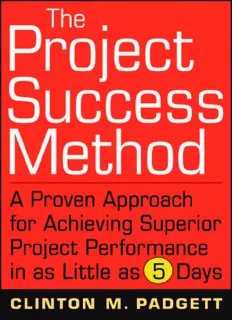Table Of ContentE1FLAST01_1 08/06/2009 8
E1FFIRS 08/06/2009 16:25:29 Page1
The
Project
Success
Method
A Proven Approach
for Achieving Superior
Project Performance in
*
as Little as 5 Days
C L I N T O N M . P A D G E T T
JohnWiley&Sons,Inc.
E1FFIRS 08/06/2009 16:25:29 Page2
Copyright#2009byClintonM.Padgett.Allrightsreserved.
PublishedbyJohnWiley&Sons,Inc.,Hoboken,NewJersey.
PublishedsimultaneouslyinCanada.
Nopartofthispublicationmaybereproduced,storedinaretrievalsystem,ortransmittedinany
formorbyanymeans,electronic,mechanical,photocopying,recording,scanning,orotherwise,
exceptaspermittedunderSection107or108ofthe1976UnitedStatesCopyrightAct,without
eitherthepriorwrittenpermissionofthePublisher,orauthorizationthroughpaymentofthe
appropriateper-copyfeetotheCopyrightClearanceCenter,Inc.,222RosewoodDrive,
Danvers,MA01923,(978)750-8400,fax(978)646-8600,oronthewebatwww.copyright.com.
RequeststothePublisherforpermissionshouldbeaddressedtothePermissionsDepartment,
JohnWiley&Sons,Inc.,111RiverStreet,Hoboken,NJ07030,(201)748-6011,fax(201)748-
6008,oronlineathttp://www.wiley.com/go/permissions.
LimitofLiability/DisclaimerofWarranty:Whilethepublisherandauthorhaveusedtheirbest
effortsinpreparingthisbook,theymakenorepresentationsorwarrantieswithrespecttothe
accuracyorcompletenessofthecontentsofthisbookandspecificallydisclaimanyimplied
warrantiesofmerchantabilityorfitnessforaparticularpurpose.Nowarrantymaybecreatedor
extendedbysalesrepresentativesorwrittensalesmaterials.Theadviceandstrategiescontained
hereinmaynotbesuitableforyoursituation.Youshouldconsultwithaprofessionalwhere
appropriate.Neitherthepublishernorauthorshallbeliableforanylossofprofitoranyother
commercialdamages,includingbutnotlimitedtospecial,incidental,consequential,orother
damages.
Forgeneralinformationonourotherproductsandservicesorfortechnicalsupport,please
contactourCustomerCareDepartmentwithintheUnitedStatesat(800)762-2974,outsidethe
UnitedStatesat(317)572-3993orfax(317)572-4002.
Wileyalsopublishesitsbooksinavarietyofelectronicformats.Somecontentthatappearsin
printmaynotbeavailableinelectronicbooks.FormoreinformationaboutWileyproducts,visit
ourwebsiteatwww.wiley.com.
LibraryofCongressCataloging-in-PublicationData:
Padgett,ClintonM.,1963—
Theprojectsuccessmethod:aprovenapproachforachievingsuperiorproject
performanceinaslittleas5days/byClintonM.Padgett.
p. cm.
Includesindex.
ISBN978-0-470-45583-8(cloth)
1. Projectmanagement. I. Title.
HD69.P75P2352009
0
658.404–dc22
2009019169
PrintedintheUnitedStatesofAmerica
10 9 8 7 6 5 4 3 2 1
E1FTOC 08/06/2009 15:13:41 Page3
Contents
Foreword DonMiller v
Preface ix
Acknowledgments xi
Chapter1
TheEasierWay 1
Chapter2
MastertheMethod 13
Chapter3
ShifttheWorryCurve 21
Chapter4
BuildaRealProjectTeam 29
Chapter5
CharterforClarity,Consensus,and
Commitment 43
Chapter6
BreakItDownandDivvyItUp 65
Chapter7
NetworkforSuccess 81
Chapter8
TrytoBeNormal 93
Chapter9
FigureOutWhat’sCritical 111
Chapter10
CompressforProfit 123
Chapter11
Monitor,Correct,andUpdate 147
Chapter12
BuildaSystemforProjectSuccess 167
Chapter13
OvercometheObjections 173
iii
E1FTOC 08/06/2009 15:13:41 Page4
iv CONTENTS
Chapter14
ApplythePowerofProjectSuccess 181
AppendixA
DevelopingOperatingProceduresfor
ProjectsInvolvingMultipleOrganizations
UsingaLinearResponsibilityChart 185
AppendixB
GeneralizedPrecedenceDiagramming 191
AppendixC
ScheduleCalculations 199
AppendixD
AnticipatingandResolvingResource
Overloads 209
AppendixE
HowtoOrganizeProjectBudgets 217
AppendixF
WhyTrackActualCosts
andResourceUsage? 223
AppendixG
TheProjectManagementOffice 225
AppendixH
ShortCaseStudies 231
AbouttheAuthor 239
Index 241
E1FLAST01_1 08/06/2009 5
Foreword
P
rojectsareapartofeverydaylife,especiallyforbusinessesand
government organizations. Yet many of us never understand
or master thefundamentalsofgood project management, which
are planning, organizing, staffing, directing, and controlling a
project over its life cycle.
Operations or processes are periodic activities that are
repeatedinthesameorsimilarmanner.Forexample,completing
the monthly close of financial books in a business is an account-
ing process. Projects, conversely, are a series of activities that
have a clear beginning, middle, and end. Of course, you could
approacheverymonthlycloseoffinancial booksasanindividual
project, but in reality this is a periodic process that is repeated
with variations over and over . . . better to develop a docu-
mented process and repeat it each month.
On the other hand, in addition to closing its books every
month, a company may also be conducting new product devel-
opmentprojects.Ineachcase,thereisadesiredoutcomeorgoal
for the new product, and most likely a schedule and budget to
completetheproject.Thecompanymayhavemanynewproduct
developmentprojectsongoing,buteachislikelytobedistinctin
terms of desired outcome, schedule, and budget.
But even in projects, there are steps taken and techniques
used over and over again. The question is: Which of these steps
andtechniquesaretheonestobetterensureasuccessfulproject?
Theanswertothisquestionisespeciallyimportantwhendealing
with the most basic issue of a project: How can I get this work
done, on this schedule, and at this price? Finding the means to
v
E1FLAST01_1 08/06/2009 6
vi FOREWORD
achieve the desired outcome, at the desired cost and schedule,
can seem impossible.
But it isn’t impossible; actually far from it. I have found by
hands-on experience starting in 1994, with small projects and
largeones,insmallentrepreneurialcompaniesandlargeFortune
500 corporations, and with high technology projects as well as
business projects—such as rolling out a new advertising cam-
paign or a new company benefits plan—that there are a set of
stepsandtechniquesthatcanstronglyshifttheoddsinfavorofa
successful project outcome. These steps and techniques help
organizations plan and execute projects successfully, and for the
first time they have been assembled by PSI into an informative
book about its Project Success Method.
TheProjectSuccessMethodhasbeentaughttohundredsof
companies and implemented in more than 10,000 projects in 25
countries on six continents over the last 25 years. The initial
PSM training requires no special pre-training or certifications
andcanbelearnedinaslittleasafewdays.Butthebesthands-on
training comes in real-world projects where you learn: (a) the
consensus-building approach that promotes team ownership of
theproject, (b) how todevelop an actionable plan withteam and
senior management commitment to that plan, and (c) the meth-
ods for a disciplined, proactive approach to project control and
on-going problem solving. The end result is projects that are
done on time and within budget and that are executed in
accordance with quality expectations.
I have two suggestions for those about to begin the Project
Success Method. First, some of the techniques may seem
counter-intuitive, but stick with them—they represent an inte-
gratedsetofprojectmanagementtoolsandtechniques.Manyof
these PSM successes have been used on very demanding, time-
critical projects. The techniques are well tested, and when used
well,haveadistinctpositivemotivationforthepeopleonproject
teams since the techniques are efficient and every step adds real
value.
E1FLAST01_1 08/06/2009 7
Foreword vii
Second,thesetechniques,asyoufirstlearnthem,mayseem
straightforward and almost simple. And, for the most part, they
are straightforward and simple. But don’t sell them short. The
real power is taking these sensible steps and applying them in a
way that can change the culture of your organization in how it
goes about projects. Culture change is hard; but once done
properly, it can be of enduring value to your organization or
business. The hard work of culture change will pay off hand-
somely for your organization.
These techniques have worked for me time and time again,
and I owe much of my business success to PSI and its Project
Success Method.
—Donald Miller, Ph.D., MBA,
Seal Beach, California
AboutDonMiller:
DonMillerinitiallytrainedasascientist,
and early in his career, he worked at McDonnell Douglas Astro-
nautics and TRW Space Technology. In mid-career, he moved
into the commercial software and information services industry,
where he worked in a series of program management, general
management,andC-levelassignments.After17yearsinsoftware
and information services—at big companies and small—Don
returned in 2003 to the aerospace industry at Northrop Grum-
man Space Technology, retiring in 2008. Don worked through-
outhiscareerinhighrankingpositionsonprojectsrangingfroma
two-year,$110milliondollarassignmentinvolving400peopleto
an Internet startup, where he was Chief Operating Officer.
E1FLAST01_1 08/06/2009 8
Description:The Project Success Method is a unique, proven and fire-tested methodology which allows companies, groups or managers to learn and develop consistency in the way they plan, schedule, manage, control and close out projects on time, per spec and within budget-- in as little as 5 days.Over the last 25

